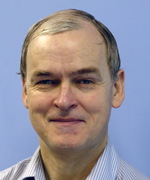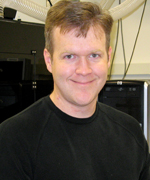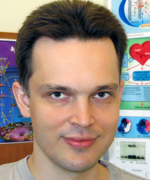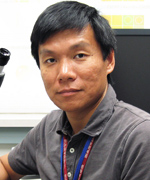Colleagues: Recently Tenured
M. CATHERINE BUSHNELL, PH.D., NCCAM
Scientific Director; Senior Investigator

Education: University of Maryland, College Park (B.S. in psychology); American University, Washington, D.C. (M.A. and Ph.D. in experimental psychology)
Training: Postdoctoral training at NEI
Before coming to NIH: Professor of anesthesiology and of dentistry and neurology; Canada Research Chair in Clinical Pain Research, McGill University (Montreal)
Came to NIH: In 1980 as staff fellow, National Institute of Dental Research (1980-1984); in July 2012 as scientific director of NCCAM
Selected professional activities: President (2011–2012) of the Canadian Pain Society; editor-in-chief of the International Association for the Study of Pain Press
Outside interests: Rock climbing; cross-country skiing; biking; kayaking
Research interests: My research is on the mechanisms of pain, the inability to feel it, and the underlying neurobiology. I study the consequences of acute pain becoming chronic, including the premature aging of the brain and cognitive dysfunction.
My team at McGill found that chronic pain causes brain changes. In chronic pain patients—including those with fibromyalgia, irritable bowel syndrome, and back pain—gray matter decreases more rapidly with age. Using positron-emission tomography (PET), we demonstrated that dopamine release is altered.
We used behavioral assays of pain, anxiety, and cognition, and magnetic-resonance imaging and PET to show that rats have increased pain sensitivity after a nerve injury but develop changes in anxiety and cognitive function and a decrease in frontal cortical gray matter several months later. When rodents with nerve injuries were placed in enriched environments, their chronic pain behavior was reduced or eliminated. An impoverished environment exacerbated the behavior. I hope that a better understanding of chronic pain will help people manage it. (For more on Bushnell, see story at https://irp.nih.gov/catalyst/v20i5/a-pain-staking-intramural-research-program.
JEAN CELLI, PH.D., NIAID
Senior Investigator, Tularemia Pathogenesis Section, Laboratory of Intracellular Parasites

Education: University Paris XI Orsay (B.S. in biochemistry and molecular genetics); University Pierre et Marie Curie, Paris (Ph.D. in microbiology)
Training: Postdoctoral training in the Biotechnology Laboratory at University of British Columbia (Vancouver, Canada)
Before coming to NIH: Institut National de la Santé et de la Recherche Médicale (France)
Came to NIH: In May 2004
Outside interests: Mountain biking; hiking; doing photography
Research interests: I am interested in understanding how infectious agents survive within host cells to generate disease. My group studies the bacterial disease-causing pathogens Brucella abortus and Francisella tularensis, which cause zoonoses, diseases that can be transmitted between animals and humans. We combine microbiology, cell biology, and genomics to identify the molecular mechanisms by which such pathogens circumvent host defense mechanisms in order to survive and replicate within mammalian cells.
Brucella abortus, the most common zoonosis, causes brucellosis, a disease that infects cattle, goats, camels, dogs, and pigs. There are an estimated 500,000 new human cases of the disease worldwide each year. We are currently characterizing the mechanisms by which Brucella survives, proliferates, persists in, and exits the host cell.
Francisella tularensis is a highly infectious bacterium that causes tularemia, a disease that affects wild rabbits and other rodents. We have identified novel virulence genes required for this pathogen’s intracellular proliferation. We are characterizing the genes’ functions to better understand the Francisella molecular virulence mechanisms.
MARK LITTLE, D.Phil., NCI-DCEG
Senior Investigator, Radiation Epidemiology Branch

Education: Trinity College, Cambridge, England (B.A. and M.A. in mathematics); New College, Oxford, England (D.Phil. in mathematics)
Before coming to NIH: Operational research executive at British Coal (London); research officer at Berkeley Nuclear Laboratories (Berkeley, England); principal scientific officer for the National Radiological Protection Board (Didcot, England); associate professor in statistics in the Department of Epidemiology and Biostatistics at Imperial College (London)
Came to NIH: In May 2010
Selected professional activities: Member of a National Council on Radiation Protection scientific subcommittee that advises on low-dose radiation; member of UK Health Protection Agency Advisory Group on Ionizing Radiation; editorial board member of Radiation and Environmental Biophysics
Outside interests: Playing viola and violin in the NIH Philharmonia orchestra and other music groups
Research interests: For 20 years, I have been developing mathematical models to analyze the relationship between radiation dose and cancer and cardiovascular disease after exposure to radiation and cigarette smoke.
I have quantified radiation-induced cancer at both low and high doses. I am exploring how low-dose exposure preconception, in utero, or postnatally is linked to the risk of pediatric leukemia. My findings suggest that 15 to 20 percent of childhood leukemias could be caused by postnatal exposure to natural background radiation.
Since joining NCI, I have been the lead statistician in the UK-NCI study of cancer risk after pediatric computed-tomography exposure and in the UK-NCI study assessing thyroid cancer risk in persons exposed during childhood to radiation fallout from the 1986 catastrophic accident at the Chernobyl Nuclear Power Plant (Ukraine).
In my high-dose radiation studies, I developed mechanistic models that explain why the relative risks of cancer in patients treated with radiation therapy are lower than in comparable subsets of the Japanese atomic bomb survivors.
I have also analyzed cardiovascular risk in moderate- and low-dose radiation-exposed groups, including the Japanese atomic bomb survivors. High-dose radiation is known to contribute to cardiovascular disease risk; the evidence for low-dose radiation, however, is inconsistent. I recently proposed a mechanism that shed light on moderate- and low-dose associations.
DORIAN MCGAVERN, PH.D., NINDS
Senior Investigator; Chief, Viral Immunology and Intravital Imaging Section

Education: Pennsylvania State University, University Park, Pa. (B.S. in microbiology); Mayo Clinic, Rochester, Minn. (Ph.D. in molecular neuroscience)
Training: Postdoctoral training in the Department of Immunology and Microbial Science, Scripps Research Institute (La Jolla, Calif.)
Before coming to NIH: Associate professor, Scripps Research Institute
Came to NIH: In March 2009
Selected professional activities: Adjunct professor at the University of Pennsylvania (Philadelphia) and at Scripps Research Institute; editorial board of IntraVital
Outside interests: Reading; seeing movies; diving
Research interests: My laboratory investigates pathogens that infect the central nervous system (CNS). Many pathogens induce serious CNS diseases, including encephalitis and meningitis, which can be caused in part by the immune system. The immune system is responsible for warding off microbes that invade all parts of the body and is therefore equipped with mechanisms to neutralize them. However, these mechanisms can sometimes cause tissue injury and disease. Many microbes can enter the CNS, and it is the unique dialogue between immune cells and the infected CNS that guides much of our research. We focus specifically on immune-cell surveillance of the infected CNS, pathogenesis of viral meningitis, mechanisms that give rise to viral persistence in the CNS and periphery, the effect of chronic innate immune stimulation during viral persistence, CNS immune regulation, and therapeutic approaches to purge persistent infections.
We use many contemporary approaches to gain novel insights into these phenomena, including intravital two-photon microscopy, a deep-tissue imaging technique that can watch immune cells respond to infections or cause disease in real time. Using this approach we have recently uncovered how the immune system damages blood vessels and induces fatal convulsive seizures during viral meningitis. We are developing new therapeutic approaches to modulate neuroinflammatory processes. The efficacy of these approaches is being evaluated using both infectious and noninfectious models of CNS inflammation.
PAL PACHER, M.D., PH.D., NIAAA
Senior Investigator; Chief, Oxidative Stress and Tissue Injury Section, Laboratory of Physiologic Studies

Education: Semmelweis University of Medicine, Budapest, Hungary (M.D.); Hungary Academy of Sciences, Budapest (Ph.D. in cardiovascular pharmacology and cardiology)
Training: Postdoctoral training in cell biology in the Department of Pathology, Anatomy, and Cell Biology, Thomas Jefferson University (Philadelphia)
Before coming to NIH: Assistant professor of pharmacology at Semmelweis University of Medicine; visiting research scientist at Thomas Jefferson Medical University; senior cardiovascular pharmacologist at Inotek Pharmaceuticals (Beverly, Mass.)
Came to NIH: In November 2002
Selected professional activities: Associate editor, Journal of Gerontology Series A; regional editor, Current Vascular Pharmacology; on the editorial boards of Free Radical Biology and Medicine and American Journal of Physiology: Heart and Circulatory Physiology
Outside interests: Traveling; doing photography; building computers
Research interests: My main research interest is the lipid endocannabinoid signaling system (ES), a promising therapeutic target against inflammatory and other diseases. The ES is involved in various physiological processes, mediates the psychoactive effects of marijuana, and may significantly influence inflammation and subsequent tissue injury. We have explored the ES’s roles in inflammation and tissue injury associated with ischemia and reperfusion (I/R), heart failure, cardiovascular inflammation, and other pathologies. Our studies have revealed that oxidative stress, which can disrupt cellular signaling, is involved in the activation of the ES, which in turn modulates important redox (oxidation-reduction) and/or inflammatory signaling pathways.We also showed that modulating peripheral cannabinoid type 2 receptors protects against I/R-induced tissue injury and vascular inflammation by decreasing the activation of endothelial cells and the inflammatory response and generating chemically reactive molecules containing oxygen or nitrogen.
We have also been exploring the therapeutic and translational potential of Cannabis sativa–derived cannabinoids or their synthetic, more stable analogs, which previously were considered to be inactive, in I/R and diabetic complications. We have found that some of the natural constituents of marijuana that do not act on conventional cannabinoid receptors and therefore lack psychoactive effects, are potent anti-inflammatory agents and may have tremendous therapeutic potential in inflammatory diseases and diabetic complications.
YIHONG YE, PH.D., NIDDK
Senior Investigator, Physical Chemistry Section, Laboratory of Molecular Biology

Education: Peking University School of Medicine, Beijing (B.S. in medicine); University of Pennsylvania, Philadelphia (Ph.D. in cell and molecular biology)
Training: Postdoctoral training in the department of cell biology at Harvard Medical School (Boston)
Came to NIH: In April 2005
Selected professional activities: Organizer of NIH’s Protein Trafficking Interest Group; member of the American Society of Cell Biology and the Society of Chinese Bioscientists in America
Outside interests: Drawing; practicing Chinese calligraphy; learning to play piano with his daughter
Research interests: My research centers on the ubiquitin proteasome system (UPS), which controls the protein-degradation process, and its roles in the protein quality-control process at the endoplasmic reticulum (ER). A cell’s protein homeostasis is maintained by eliminating aberrantly folded proteins. Defects in this process result in ER stress, which has been implicated in the pathogenesis of type 2 diabetes, cancer, and other diseases. We are trying to gain a better understanding of the molecular mechanisms that shuttle misfolded proteins from the ER into the cytosol, the liquid part of the cell, where they are degraded.
We have identified a cytosolic ATPase called p97 that drives the substrates into the cytosol for degradation. We also discovered a membrane protein complex that interacts with p97 to mediate the transport of substrates into the cytosol. Recently, we found a chaperone holdase that is essential for maintaining the solubility of misfolded ER proteins, a condition required for their turnover. We are investigating how these different machineries cooperate to act in ER quality control. We are also interested in determining additional functions of p97 by searching for novel interaction partners.
We are also exploring several other aspects of the UPS that are relevant to ER protein quality control. We are breaking apart the mechanism by which polyubiquitin chains are formed on a substrate, a process essential for the degradation of misfolded ER proteins as well as many short-lived proteins in eukaryotes. We are also examining how deubiquitinating enzymes disassemble ubiquitin conjugates to facilitate protein turnover. My long-term goal is to understand the various strategies used by cells to maintain protein homeostasis. We hope to use the knowledge to establish new therapeutics for type 2 diabetes and cancer.
This page was last updated on Friday, April 29, 2022
